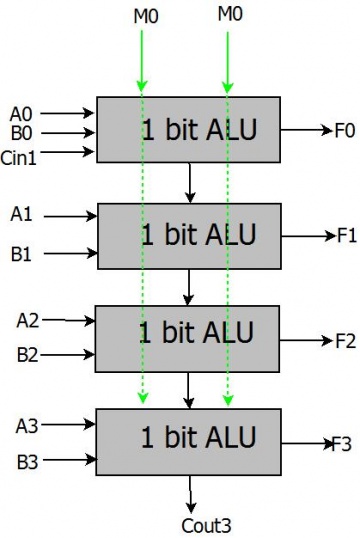Arithmetic Logic Unit
Table of contents
Introduction
An arithmetic logic unit (ALU) is a digital circuit used to perform arithmetic and logic operations. It represents the fundamental building block of the central processing unit (CPU) of a computer. Modern CPUs contain very powerful and complex ALUs. In addition to ALUs, modern CPUs contain a control unit (CU).
The purpose of the ALU is to perform mathematical operations such as addition, subtraction, multiplication and division. Additionally, the ALU processes basic logical operations like AND/OR calculations. It serves as the computational hub of the Central Processing Unit (CPU) for a computer system
In detail
So with the above building blocks i.e. half adder and full adder discussed in Combinational Analysis, lets construct a simple ALU that performs a arithmetic operation (1 bit addition) and does 3 logical operations namely AND, NOR and XOR as shown below. The multiplexer selects only one operation at a time. The operation selected depends on the selection lines of the multiplexer as shown in the truth table.
Input = M0,M1 & Output = Operation
| M0 | M1 | Operation |
|---|---|---|
| 0 | 0 | SUM |
| 0 | 1 | AND |
| 1 | 0 | OR |
| 1 | 1 | XOR |
Now you can take up the 1 bit ALU as block and construct a 4 bit ALU, which performs all the functions of the 1 bit ALU on the 4 bit inputs. Thus a single building block can be constructed and used recursively. The inputs A and B are four bits and the output is 4 bit as well. Figure below illustrates it:

There are a few important takeaways here:
- The selection lines MO and M1 select the function ALU performs. These selection lines combined with the input arguments and desired functions, an Instruction Set can be formed.
- These Instructions can used to create meaningful programs. Since these are required to be easily available, they can be stored on ROM unit.
- The input arguments A and B are often stored in Internal Registers. These along with other special purpose register form the registers of the microcontroller.
- ROM memories are slower in speed, hence an intermediate high speed RAM is often used.
- All the critical timings, decoding of the instructions are often grouped together in seperate control and timings unit.
- If a Micro controller would be constructed only from ALU, RAM and ROM, there would not be any external interface. Hence, you now have Input/Output (I/O) ports.
- Additional features such as Interrupts, communication protocols, EEPROM, Timers/Counters, Debug interfaces etc. are incorporated to make a controller complete.
In above discussion you might have left out intricate details involved in an ALU, CPU design. But the aim was to understand ALU/CPU at a deeper level.